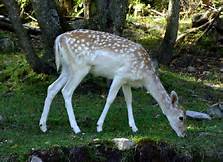& Food Chains
What is a producer?
A. an organism that gets energy from eating other organisms
B. an organisms that uses sunlight to make its own food
C. an organism that gets energy from eating dead organisms, non-living material or waste
D. an organism that uses chemical energy to make its own food
What is a herbivore?
A. an animal that gets energy from eating other animals
B. an organism that gets energy from eating only plants
C. an animal that gets energy by eating both plants and other animals
D. an animal that eats only herbs
An organism that gets energy from breaking down dead organisms, non-living material or waste is a(an) ___________.
A. producer
B. consumer
C. decomposer
D. autotroph
What is the source of all energy in an ecosystem?
A. producers
B. consumers
C. decomposers
D. sun
A connection of food chains with many food energy paths in an ecosystem is a ____________.
A. ecosystem
B. food web
C. environment
D. population
Which best describes grasses, shrubs, and trees?
A. producers
B. consumers
C. decomposers
D. scavengers
An organism that gets energy from eating other organisms is a ______________.
A. producer
B. consumer
C. decomposer
D. prey
How do decomposers recycle dead trees?
A. by releasing oxygen
B. by turning them into soil
C. by turning them into producers
D. by making them food for consumers
A. producers
B. consumers
C. decomposers
D. predators
Which of the following is a living part of the ecosystem?
A. Air
B. Sunlight
C. Mushroom
D. Soil
The process of using sunlight, carbon dioxide, and water to make sugar and oxygen is called _________?
A. chlorophyll
B. evaporation
C. photosynthesis
D. transportation
How is a deer in a forest ecosystem most similar to a rabbit in the same ecosystem?
A. both are decomposers
B. both are carnivores
C. both are consumers
D. both are producers
Which group lists only decomposers?
A. tadpoles, frogs, and algae
B. shrimp, crayfish, and turtles
C. bacteria, mushrooms, and earthworms
D. vultures, hawks, and eagles
What would most likely happen if an ecosystem no longer received sunlight?
A. The number of herbivores would increase
B. The number of plants would increase
C. All organisms would adapt
D. All living organisms would eventually die
The shrew provides energy for the _______.
A. cricket
B. grasshopper
C. frog
D. snake
Organisms that can capture energy from inorganic materials and convert it into forms living cells can use.
A. autotrophs
B. chemotrophs
C. heterotroph
D. consumer
What type of organisms are consumers?
A. Scavengers
B. Heterotrophs
C. Autotrophs
D. Decomposers
Decomposers affect all levels of the food web.
True
False
Which organism receives its energy from the sun?
A. bee
B. algae
C. shrimp
D. earthworm
The arrows in a food chain or web represents what?
A. They point to the organism that is being eaten.
B. It shows how sunlight flows within an ecosystem.
C. They show what direction the energy is flowing between organisms.
D. They represent how water is transferred within a habitat.
first producer of energy-rich compounds that are later used by other organisms is called _________.
A. primary consumer
B. primary producer
Why is a racoon classified as an omnivore?
A. A racoon eats only animals.
B. A racoon eats only plants.
C. A racoon makes its own food.
D. A racoon eats plants and animals.
A. Producer
B. Consumer
C. Decomposer
In the energy pyramid here, how much of the energy in each level gets lost as heat or used by the organism for survival?
A. 80%
B. 90%
C. 10%
D. 20%
Which of the following is a herbivore?
A. cricket
B. frog
C. hawk
D. shrew









